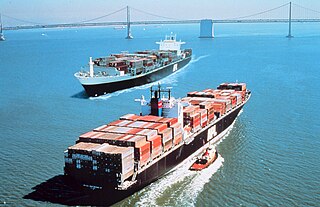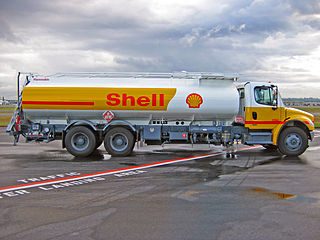
HMS Ocean was an amphibious assault ship, formerly the UK's helicopter carrier and the fleet flagship of the Royal Navy. She was designed to support amphibious landing operations and to support the staff of Commander UK Amphibious Force and Commander UK Landing Force. She was constructed in the mid-1990s by Kvaerner Govan on the River Clyde and fitted out by VSEL at Barrow-in-Furness prior to trials and subsequent acceptance in service. Ocean was commissioned in September 1998 at her home port HMNB Devonport, Plymouth.

HMS Hermes was a conventional British aircraft carrier and the last of the Centaur class.

HMS Cardiff was a British Type 42 destroyer and the third ship of the Royal Navy to be named in honour of the Welsh capital city of Cardiff.
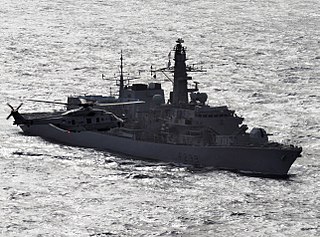
HMS Richmond is a Type 23 frigate of the Royal Navy. She was launched on 6 April 1993 by Lady Hill-Norton, wife of the late Admiral of the Fleet The Lord Hill-Norton, and was the last warship to be built by Swan Hunter Shipbuilders. She sailed from the builders on the River Tyne in November 1994. She is named for the Dukedom of Richmond.

HMS Brilliant was a Type 22 frigate of the Royal Navy.
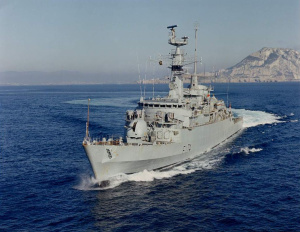
HMS Alacrity was a Type 21 frigate of the Royal Navy.

RFA Argus is a ship of the Royal Fleet Auxiliary operated by the MoD under the Blue Ensign. Italian-built, Argus was formerly the container ship MVContender Bezant. The ship was requisitioned in 1982 for service in the Falklands War and purchased outright in 1984 for use as an Aviation Training Ship, replacing RFA Engadine. In 1991, during the Gulf War, she was fitted with an extensive and fully functional hospital to assume the additional role of Primary Casualty Receiving Ship. In 2009, the PCRS role became the ship's primary function. Argus is due to remain in service until 2024.
Atlantic Conveyor was a British merchant navy ship, registered in Liverpool, that was requisitioned during the Falklands War.
RFA Regent A486 was an ammunition, explosives, and stores supply ship in the 'Royal Fleet Auxiliary'. She was built by Harland and Wolff, commissioned in 1967 and took part in the Falklands War.

HMS Argonaut (F56) was a Leander-class frigate that served with the Royal Navy from 1967 to 1993. She took part in the Falklands War in 1982, sustaining damage and casualties in action.

HMS Danae was a Leander-class frigate of the Royal Navy. She was, like the rest of the class, named after a figure of mythology. Danae was built by Devonport Dockyard. She was launched on 31 October 1965 and commissioned on 10 October 1967.
HMS Hydra was a Royal Navy deep ocean hydrographic survey vessel, the third of the original three of the Hecla class. The ship was laid down as yard number 2258 on 14 May 1964 at Yarrow Shipbuilders, at Scotstoun on the River Clyde and launched on 14 July 1965 by Mary Lythall, wife of the then Chief Scientist, Basil W Lythall CB (1919–2001). She was completed and first commissioned on 4 May 1966 and, as the replacement for the survey ship HMS Owen, her commanding officer and many of her ship's company formed the first commission of HMS Hydra. She was decommissioned and sold to the Indonesian Navy in 1986 and renamed KRI Dewa Kembar ; she was still in service in 2006.

Operation Paraquet was the code name for the British military operation to recapture the island of South Georgia from Argentine military control in April 1982 at the start of the Falklands War.
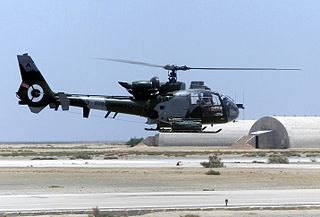
847 Naval Air Squadron is a squadron of the Royal Navy Fleet Air Arm. It operates AgustaWestland Wildcat AH.1 helicopters and provides armed reconnaissance and light transport support to 3 Commando Brigade Royal Marines. Along with 845 and 846 naval air squadrons, it forms part of the Commando Helicopter Force. The squadron was re-formed from 3 Commando Brigade Air Squadron on 1 September 1995.
Cape Pembroke is the easternmost point of the Falkland Islands, and is on East Falkland. There is an automated lighthouse here.

The 1982 British military campaign to recapture the Falkland Islands depended on complex logistical arrangements. The logistical difficulties of operating 7,000 nautical miles from home were formidable. The Argentine invasion of the Falkland Islands came at a time when the Royal Navy's amphibious capability was being run down; but it still possessed two aircraft carriers, HMS Hermes and Invincible, two landing platform dock (LPD) ships, HMS Fearless and Intrepid, and six landing ship logistics (LSL) ships. To provide the necessary logistic support, the Royal Navy's ships were augmented by ships taken up from trade (STUFT).
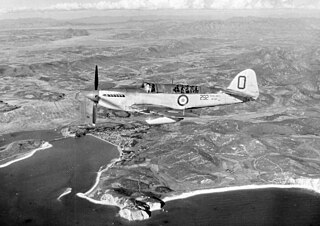
825 Naval Air Squadron is a Royal Navy Fleet Air Arm Naval Air Squadron which was re-commissioned on 10 October 2014 and currently flies the AgustaWestland Wildcat HMA.2.
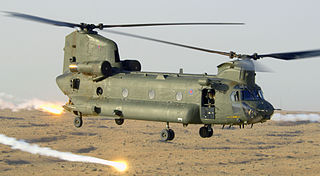
Bravo November is the original identification code painted on a British Royal Air Force Boeing Chinook HC4 military serial number ZA718. It was one of the original 30 aircraft ordered by the RAF in 1978 and has been in service ever since. It has been upgraded several times in its history, now being designated as an HC4 airframe. It has seen action in every major operation involving the RAF in the helicopter's 30-year service life. Since 1982 it has served in the Falkland Islands, Lebanon, Germany, Northern Ireland, Kurdistan, Iraq and Afghanistan. The aircraft has seen four of its pilots awarded the Distinguished Flying Cross for actions whilst in command of Bravo November.

MS Baltic Ferry was built in 1978 by South Korean-based Hyundai H.I. for Stena Lines who had intended her, and 10 sister ships to be used for charter or sale to other operators. She was chartered by Townsend Thoresen in 1980, staying with them and their successor P&O Ferries and P&O Irish Sea until 2005. In 1982 the Ministry of Defence requisitioned the vessel to transport troops to the Falkland Islands.

